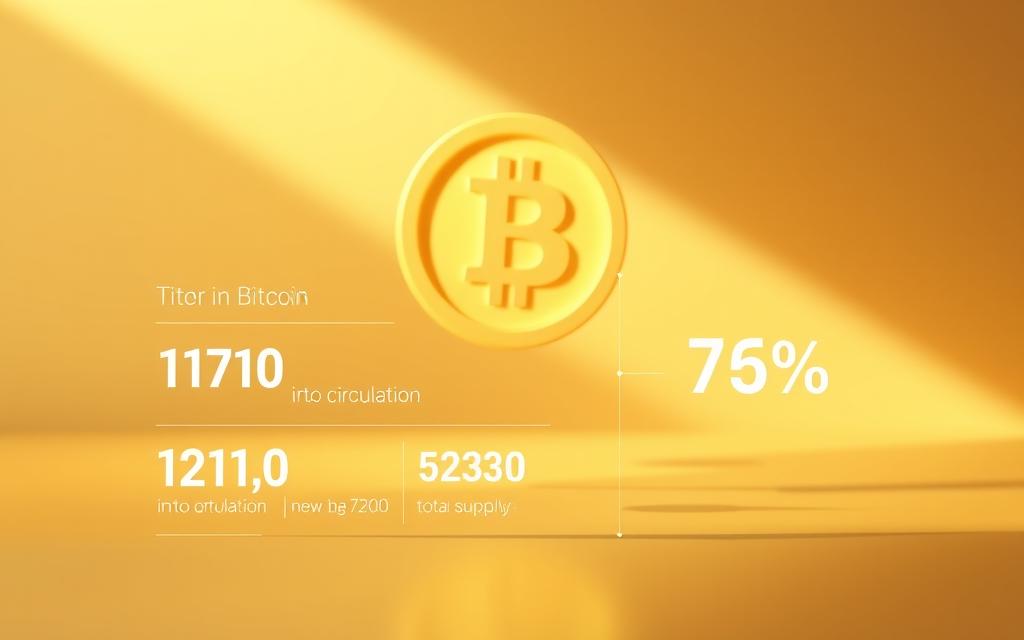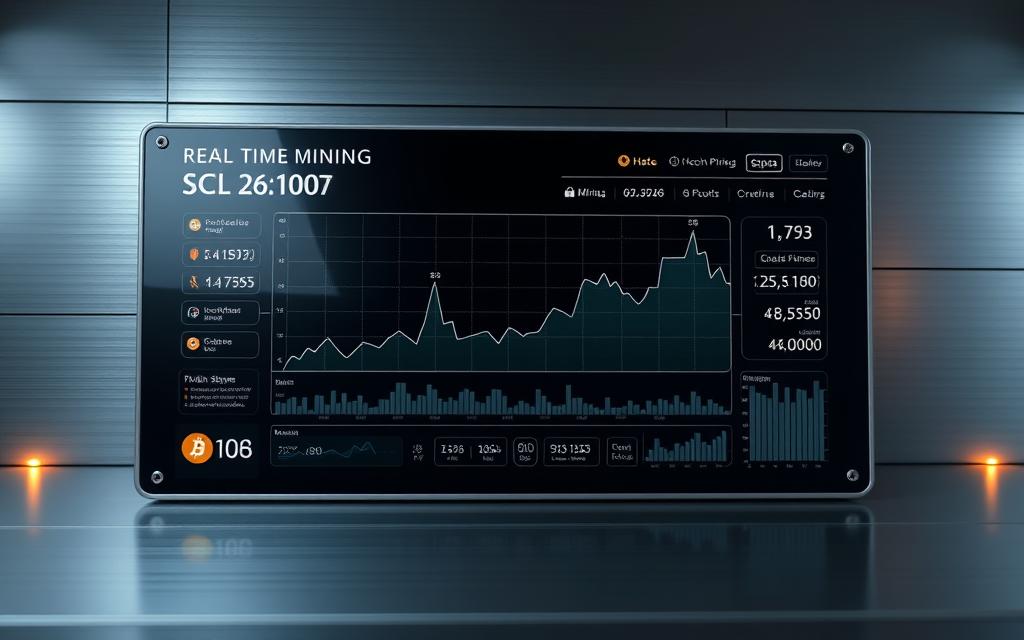Table of Contents
The world of cryptocurrency is abuzz with the question of Bitcoins remaining to be mined. With a capped supply of 21 million, understanding the current state of mining is crucial.
Currently, there are approximately 19.5 million bitcoins in circulation, leaving about 1.5 million to be mined. This number changes every 10 minutes as new blocks are mined, gradually approaching the total supply limit.
This comprehensive guide explores the current mining landscape, examining the supply cap’s implications on Bitcoin’s value and the economics of its diminishing circulation.
As we delve into the details, we’ll analyze the current rate of mining and its impact on Bitcoin’s long-term viability as a digital asset.
Bitcoin’s Limited Supply: Understanding the 21 Million Cap
The total supply of Bitcoin is capped at 21 million, a design choice that sets it apart from traditional currencies. This limit is not arbitrary; it’s a deliberate feature designed to create a form of digital scarcity.
Why Bitcoin Has a Supply Limit
Bitcoin was designed with a hard cap to prevent inflation and ensure the value of each coin. Satoshi Nakamoto implemented this limit to differentiate Bitcoin from fiat currencies, which can be printed indefinitely. The mathematical algorithm governing Bitcoin ensures this cap cannot be changed without consensus from the entire network.
How Scarcity Affects Bitcoin’s Value
The scarcity created by the 21 million cap contributes to Bitcoin’s value. As demand increases and the supply remains fixed, the price tends to rise. This scarcity model is similar to that of precious metals like gold, making Bitcoin a potential store of value.
Current Bitcoin Circulation Statistics
Bitcoin’s circulating supply has reached a significant milestone, with about 93% of the total possible supply already mined. At the time of writing, there are approximately 19.5 million Bitcoins in circulation.
How Many Bitcoins Exist Today
The current number of Bitcoins in existence is a result of the mining process that started in 2009. As of now, around 19.5 million Bitcoins have been mined, representing about 93% of the total possible supply of 21 million.
Visualizing Bitcoin’s Circulating Supply
To better understand the proportion of Bitcoins already mined, let’s look at the data in a table:
| Total Bitcoin Supply | Circulating Supply | Percentage Mined |
|---|---|---|
| 21 million | 19.5 million | 93% |

The table illustrates that the majority of Bitcoins have already been mined, with only a small percentage remaining to be created. This scarcity is a fundamental aspect of Bitcoin’s design and has significant implications for its value and the mining process.
How Many Bitcoin Are Left to Mine
As we edge closer to the 21 million Bitcoin limit, understanding the remaining supply becomes crucial. With a total cap of 21 million, the remaining Bitcoins are being mined at a decreasing rate due to the Bitcoin protocol’s design.
“The scarcity of Bitcoin is a key factor in its value,” as noted by experts, highlighting the importance of understanding the remaining supply.
Remaining Bitcoin Supply Breakdown
Approximately 1.5 million Bitcoins remain to be mined, representing about 7% of the total supply. This relatively small percentage will take until around 2140 to be fully mined due to the protocol’s issuance schedule and halving events.
Mining Rate and Issuance Schedule
The current mining rate is approximately 900 new Bitcoins per day. However, this rate changes over time due to the periodic halving events, which slow down the mining process, extending the timeline to reach the maximum supply.
Understanding the remaining supply is crucial for investors and miners as it directly impacts Bitcoin’s scarcity and potential future value.
The Bitcoin Mining Process Explained
At the heart of the Bitcoin network is the mining process, which is responsible for creating new Bitcoins and securing the network. This process involves validating transactions and adding them to the blockchain.
How New Bitcoins Are Created
Bitcoin mining is the process by which new bitcoins are created and transactions are verified and added to the blockchain. Miners compete to solve complex mathematical problems using specialized hardware, with the winner earning the right to add the next block to the blockchain.
Block Rewards and Mining Difficulty
Miners are rewarded with block rewards plus transaction fees for their work securing the network. The mining difficulty automatically adjusts approximately every two weeks to maintain a consistent block time of about 10 minutes, regardless of how much mining power joins the network.
| Aspect | Description |
|---|---|
| Mining Process | Validating transactions and creating new Bitcoins |
| Block Rewards | Newly created Bitcoins awarded to miners for securing the network |
| Mining Difficulty | Adjusts every two weeks to maintain a consistent block time |

Bitcoin Halving Events and Their Impact
The Bitcoin network is designed to undergo halving events approximately every four years, a process that affects block rewards for miners. This programmed event is crucial in controlling the supply of new Bitcoins entering circulation.
What Is a Bitcoin Halving?
A Bitcoin halving is an event where the reward for mining new blocks is cut in half. This occurs every 210,000 blocks, or roughly every four years. The halving is a key component of Bitcoin’s monetary policy, enforcing scarcity and reducing the rate of new coin issuance.
Key aspects of Bitcoin halving include:
- Reduction of block reward by half
- Occurrence every 210,000 blocks or approximately every four years
- Mechanism to enforce Bitcoin’s scarcity
Past and Future Halving Dates
Historically, Bitcoin halving has occurred in 2012, 2016, and 2020, with the block reward decreasing from 50 BTC to 25 BTC, then to 12.5 BTC, and finally to 6.25 BTC. The next halving is anticipated in 2024, which will further reduce the block reward to 3.125 BTC.
| Halving Year | Block Reward (BTC) |
|---|---|
| 2009 | 50 |
| 2012 | 25 |
| 2016 | 12.5 |
| 2020 | 6.25 |
| 2024 (Expected) | 3.125 |

The Timeline to Mine the Last Bitcoin
Understanding the timeline to mine the last bitcoin requires examining Bitcoin’s halving mechanism. The halving schedule is designed to slow down the issuance of new bitcoins over time.

Why 2140 Is the Estimated End Date
The last bitcoin is projected to be mined around 2140, approximately 120 years from now. This extended timeline is a result of Bitcoin’s programmed halving schedule, which gradually reduces the block reward.
Final Block Rewards Before Zero
The block reward will become increasingly smaller with each halving, eventually reaching just 0.000000011641532 BTC per block before the final bitcoin is mined. This gradual reduction ensures a smooth transition from block rewards to transaction fees as the primary incentive for miners.
Lost Bitcoins: The Permanently Inaccessible Supply
The phenomenon of lost bitcoins has a profound impact on Bitcoin’s scarcity, effectively reducing the total supply and potentially increasing its value.

Estimating How Many Bitcoins Are Lost Forever
Estimates suggest that between 3-4 million bitcoins are lost forever, which accounts for approximately 15-20% of the total supply. This loss is primarily due to forgotten passwords, lost private keys, and hardware failures.
Impact of Lost Coins on Total Supply
The permanently lost coins contribute to the overall scarcity of Bitcoin, potentially enhancing its long-term value proposition. Understanding the impact of lost coins is crucial for accurately assessing Bitcoin’s true circulating supply and future economic dynamics.
Daily Bitcoin Production and Mining Rate
Bitcoin’s daily mining output is influenced by several key factors. The Bitcoin protocol is designed to maintain a consistent block time, which in turn affects how many new Bitcoins are mined daily.
How Many Bitcoins Are Mined Every Day
Currently, approximately 900 new Bitcoins are mined daily, based on the average of 144 blocks mined per day with a reward of 6.25 BTC per block. This rate is subject to change due to the protocol’s design.

Factors Affecting Mining Speed
The Bitcoin protocol adjusts mining difficulty every 2,016 blocks, roughly every two weeks, to maintain a consistent block time of about 10 minutes. Factors such as total network hash rate, mining difficulty adjustments, and technological advancements in mining hardware affect the daily production rate. After the next halving in 2024, daily production will drop to approximately 450 Bitcoins per day.
| Metric | Current Value | Post-Halving Value (2024) |
|---|---|---|
| Blocks per Day | 144 | 144 |
| BTC per Block | 6.25 | 3.125 |
| BTC per Day | 900 | 450 |
What Happens When All Bitcoins Are Mined?
Once all 21 million Bitcoins are mined, the network will undergo a fundamental transformation in its mining economics. The mining process will continue, but the incentives for miners will shift.
Transition to Transaction Fee-Based Mining
After the last Bitcoin is mined, miners will rely on transaction fees to validate transactions and maintain the blockchain. This transition is expected to significantly impact mining economics. Miners will need to adapt to a new revenue stream, focusing on transaction fees rather than block rewards.
| Revenue Stream | Pre-All Bitcoins Mined | Post-All Bitcoins Mined |
|---|---|---|
| Block Rewards | Primary | None |
| Transaction Fees | Supplementary | Primary |
Long-Term Network Security Considerations
The long-term security of the Bitcoin network will depend on sufficient transaction volume and fee levels to incentivize miners to continue securing the network. As the last bitcoin is mined, the network’s security model will be tested. Ensuring that transaction fees are adequate to support network security will be crucial.

Bitcoin’s Scarcity vs. Traditional Currencies
Bitcoin’s unique economic model is largely defined by its scarcity, stemming from a fixed supply of 21 million. This characteristic sets it apart from traditional fiat currencies, which can be printed indefinitely.
Comparing Bitcoin to Fiat Money Inflation
Bitcoin’s annual inflation rate, currently under 2%, will continue to decrease with each halving event, eventually approaching zero. In contrast, fiat currencies typically experience inflation rates between 2-3% annually, leading to a consistent loss of purchasing power over time.
| Currency | Supply Mechanism | Inflation Rate |
|---|---|---|
| Bitcoin | Fixed supply cap | Decreasing, approaching 0% |
| Fiat Currencies | Can be printed indefinitely | Typically 2-3% annually |
Bitcoin as a Store of Value
The scarcity model of Bitcoin resembles that of precious metals like gold but with more predictable supply constraints. As a result, many investors view Bitcoin as a potential hedge against inflation and currency debasement in traditional financial systems, making it an attractive store of value.

How Bitcoin’s Limited Supply Affects Its Price
The finite supply of Bitcoin introduces a scarcity-driven economic model that impacts its price. As the supply approaches its limit, demand is pushed up by scarcities, which boosts the value.
Supply and Demand Economics
Bitcoin’s fixed supply cap creates a unique economic environment where price is primarily determined by demand against an increasingly constrained supply. This dynamic makes Bitcoin more attractive compared to fiat currencies with nearly unrestricted issuance.
Historical Price Trends After Halvings
Historical data shows that previous halving events have typically preceded significant bull markets as the reduction in new supply impacts market dynamics. Analyzing these trends can provide insights into how Bitcoin’s diminishing supply growth relates to its market valuation.

Conclusion: The Future of Bitcoin’s Remaining Supply
The diminishing supply of Bitcoin will have far-reaching implications for miners, investors, and the network as a whole. As we’ve explored, the remaining 1.5 million Bitcoins will take over a century to mine due to the halving mechanism. As mining rewards decrease, transaction fees will become the primary incentive for miners to maintain network security.
This shift will reshape the mining industry and Bitcoin’s security model in the coming years and decades. Understanding Bitcoin’s supply mechanics is crucial for anyone participating in the Bitcoin ecosystem, whether as an investor, miner, or user of the network.
FAQ
What is the total supply of Bitcoin?
The total supply of Bitcoin is capped at 21 million coins, making it a scarce digital asset.
What happens when all Bitcoins are mined?
When all Bitcoins are mined, miners will rely on transaction fees as their primary source of revenue, ensuring the continued security of the network.
How often does the Bitcoin halving occur?
The Bitcoin halving occurs approximately every four years, reducing the block reward and slowing down the issuance of new Bitcoins.
What is the purpose of the Bitcoin halving?
The Bitcoin halving is designed to control inflation and maintain the scarcity of Bitcoin by reducing the rate at which new coins are released.
How many Bitcoins are lost forever?
It’s estimated that several million Bitcoins are lost forever due to forgotten private keys, misplaced wallets, and other factors.
What is the impact of lost Bitcoins on the total supply?
Lost Bitcoins reduce the total circulating supply, potentially increasing the value of the remaining coins due to increased scarcity.
When is the estimated end date for mining all Bitcoins?
The estimated end date for mining all Bitcoins is around 2140, based on the current block reward schedule and halving events.
How does the Bitcoin network ensure security after all Bitcoins are mined?
The Bitcoin network will rely on transaction fees to incentivize miners to continue validating transactions and securing the network.
How does Bitcoin’s scarcity compare to traditional fiat currencies?
Bitcoin’s fixed supply contrasts with fiat currencies, which can be printed in unlimited quantities, potentially leading to inflation and devaluation.
What is the relationship between Bitcoin’s supply and its price?
The scarcity of Bitcoin, combined with increasing demand, can drive up its price over time, as seen in historical price trends after halving events.









